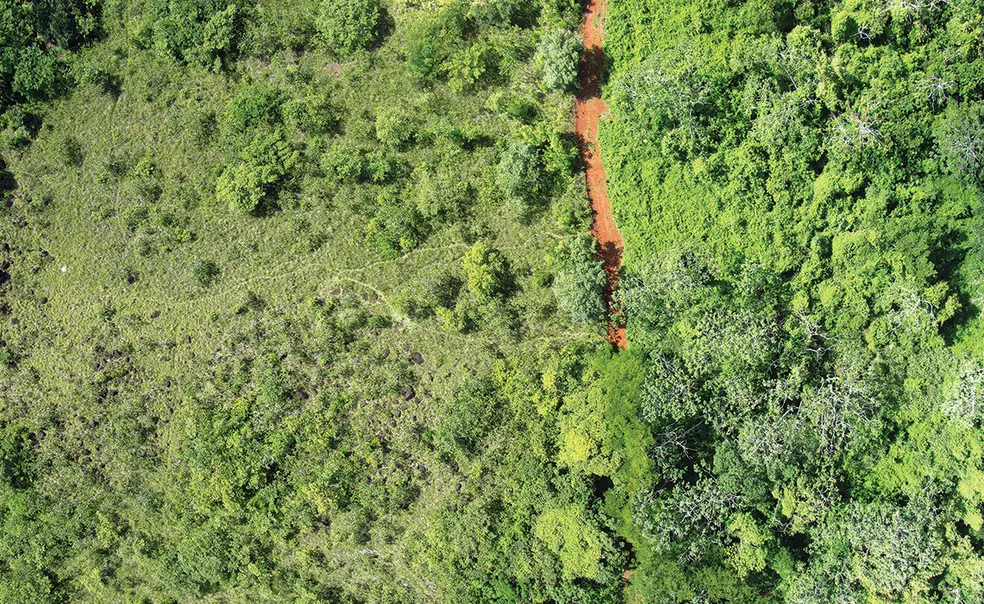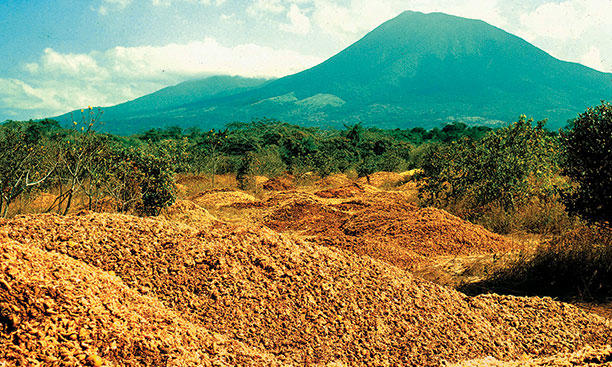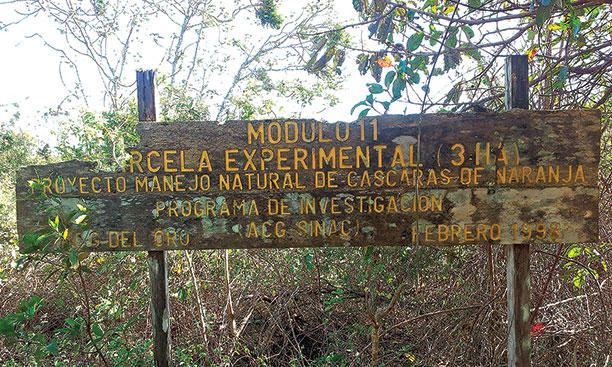Ecology and Evolutionary Biology: Greener Shade of Orange
Thousands of tons of discarded orange peels spur vibrant reforestation
The 6-foot-wide wooden sign, carved with simple yellow lettering, seemed to have evaporated into thin air. Or at least that’s what Tim Treuer, a graduate student in Princeton’s department of ecology and evolutionary biology, and Jon Choi ’15, an EEB graduate, thought. In 2014, the researchers scoured the 7-acre plot for the sign that had been placed there more than 15 years earlier, but bramble and dense vegetation now covered the once-barren pastureland in northwestern Costa Rica.
“This huge wooden sign was actually no more than 8 feet off the dirt road that we walked in and out of every single time we visited the site,” says Treuer. “It was just so covered in vines, and the forest regrowth was so lush, that we completely missed it. [When] I was absolutely sure that I’d found the site ... I was totally floored.”
In 1997, a local fruit company dumped and spread 1,000 truckloads of orange peels on this plot — and according to new research, the number of tree species has since tripled and the thickness of the tree growth has increased 176 percent. The canopy cover of this area is visibly more abundant than the untouched land next to it in aerial photos. The soil also benefited, showing significant increases in both the macro- and micronutrients that plants need to grow. The newly verdant forest constitutes a “carbon sink,” clawing back climate-warming carbon dioxide from the air — all thanks to the fruity compost.
The novel experiment was spearheaded in 1997 by ecologists Winnie Hallwachs ’76 and her husband, Dan Janzen. Janzen had been speaking with the manager of Costa Rican fruit company Del Oro, which was planning to open a juice plant. “When asked what they would do with the peels, [Del Oro] said they would build a separate diesel-fired plant to dry and pellet the peels as cattle food,” Hallwachs explains. Looking out over the swaths of untouched forest that Del Oro owned, Janzen suggested that the company trade some of that land to the neighboring Área de Conservación Guanacaste (ACG), a national park, in exchange for regularly biodegrading its processed orange peels for free on some barren pasture within the ACG. The idea was to expand the ACG’s stretch of protected forest and trigger a much-needed reforestation while offering the fruit company a cheap, eco-friendly alternative to the multimillion-dollar plant it would need to build to process the peels.
“So we picked out a badly degraded pasture [that was] part of an old ranch,” Hallwachs says. “The orange peels were dumped and spread; the wild organisms, wind, and rain went to work; and we or other humans visited only occasionally.”
Shortly after Del Oro deposited its initial 1,000 truckloads of peels, rival fruit company TicoFrut successfully sued the company, arguing the deal defiled a national forest. All plans for future orange-peel dumps were abandoned.
In 2013, Treuer was conducting research nearby, so he decided to visit the site, having heard about the project from Janzen. When he got there, he discovered the incredible transformation. Janzen’s project had “worked beautifully,” Hallwachs says, but “until Tim and Jon began their very detailed measurements, the obvious success of the project at nursing new vegetation was evaluated only by a few plant surveys and by eye.” Choi, who is now a joint J.D./Ph.D. student at Duke Law School and Duke’s Nicholas School of the Environment, helped Treuer conduct research the following year, and the two co-authored the resulting study with Hallwachs, Janzen, and six other collaborators. The paper was published in July in the journal Restoration Ecology.
“There’s an opportunity to explore these interactions between agriculture and the restoration and regeneration of tropical forests,” says Choi, who turned the 2014 research trip into his senior thesis. Ecologists worry about tropical deforestation stripping away the plants needed to remove carbon dioxide from the air, but “what if we could reverse the clock ... and regrow a forest?” Choi asks. “That’s important for biodiversity and for climate change.”
Hallwachs points out that the orange peels were particularly suited to composting because they had been stripped of their essential oils (to be used in consumer products), making them faster and easier to decompose. Treuer notes that further experimentation is needed to determine whether the results could be recreated using other organic material.
Because tropical-forest preservation usually comes with a high price tag, the fact that dumping the peels cost Del Oro virtually nothing is revolutionary, Treuer adds.
“If you can replicate what happened at our site in Costa Rica in other settings, you’re talking about a game-changer for tropical forest restoration,” he says.















No responses yet